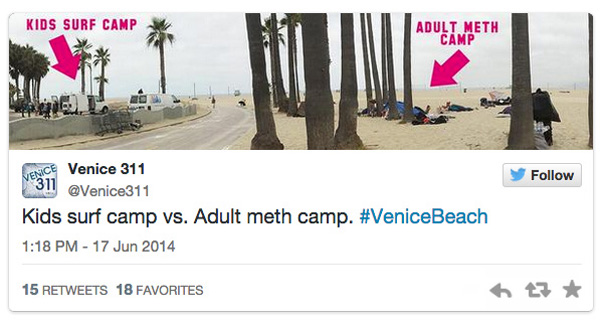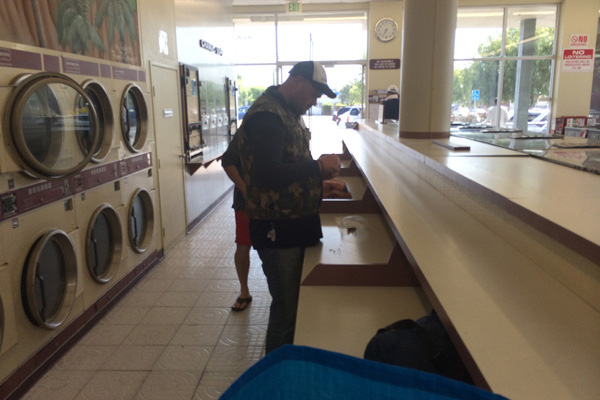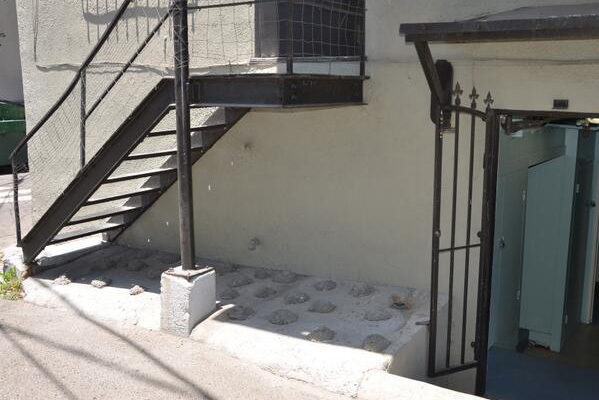Venice Beach Open Air Insane Asylum
15/05/2014
Most major cities have a homeless population; London certainly has, so does New York, San Francisco and Los Angeles. Especially Los Angeles. Virtual shanty towns can often be seen underneath freeway overpasses and on the West Side, up and down the beaches, the problem is particularly visible. From Santa Monica all the way down to Redondo Beach until you get to Palos Verdes, pockets of homeless people can be found, with a prominent concentration in Venice.
Imagine Camden on Sea, that’s pretty much what Venice is like. Imagine it’s summer every single weekend, everyone is dressed in shorts and t-shirts and every convertible has its roof down. All the way up Speedway and down the Ocean Front Walk, the air hangs heavy with the smell of marijuana. I suppose if I was penniless, homeless and hungry, then this might sound like an appealing place to spend my time, as one sunny day seamlessly blurs into the next.

Venice is not just a magnet for the destitute; hippies, hipsters, meth heads, musicians, sculptors, free spirits, stoners and tourists alike, all flock to this focal point of creative energy. It overflows with a variety of colourful markets, shops, restaurants, bars, pubs and clubs. A friend once described Venice as an “open-air insane asylum” and it wasn’t long before I came to see exactly what he meant.
Needless to say, drugs play a major role with many who live in the area. Be it the homeless who spend most of the day curled up in their makeshift camps, emerging only in the late afternoon or the countless number of smokers puffing away throughout the day. Most users are harmless, but every now and again you’ll come across someone who has had their brains…fried. Honestly, it’s the only way to describe it.

Cutting up your weed in the middle of a launderette, as you do…in Venice anyway
Back in 2007, when Michael Bloomberg was mayor of New York, the city implemented a policy where one-way tickets, by bus or by plane, were given to homeless people. Recipients had to demonstrate they had a family somewhere that was willing to take them in, and they were free to choose whether they want to participate in the program. Most were sent to destinations within the United States, but some were sent as far away as India, Russia and Peru.
Of course the jury is still out on whether this is actually a solution or simply a matter of shifting the problem out of state.
Hawaii recently made the headlines, when its Institute for Human Services (IHS) announced a $1.3million initiative to fight homelessness. The state is aiming to fly 120 homeless people living in Waikiki, a tourist hotspot in Honolulu, back to the continental US, while also allocating funds for a public relations campaign discouraging homeless people living on the mainland from moving to the state – a move some say contradicts Hawaii’s usual warm welcome to visitors.

A low-budget, improvised equivalent of ‘anti-homeless spikes’
“We found out that many [Waikiki homeless] are transient who made a choice to become homeless, as well as people who became homeless shortly after arriving in Hawaii,” Kimo Carvalho, development and community relations manager for IHS, told Civil Beat. He noted a glamorized and inaccurate depiction of homelessness in Hawaii has enticed many individuals to choose that lifestyle over other options, causing problems for Waikiki businesses that have argued homelessness in the area hurts tourism. According to the New York Times, Hawaii has witnessed a 32% hike in its homeless population over the last five years.
The weather in Venice is quite similar to that of Hawaii, I wonder how many of them will end up here.
Follow Londoner in LA on Twitter at @londonerinla